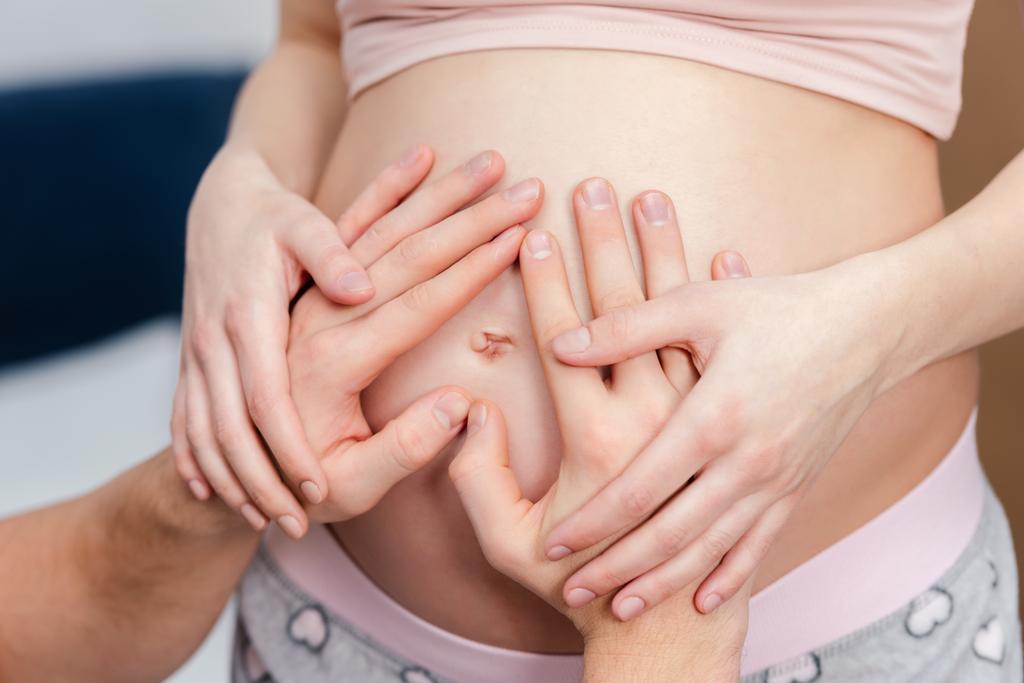Congratulations on reaching the second trimester of your pregnancy! This phase, spanning from weeks 13 to 26, is often referred to as the “golden period” due to the positive changes many expectant mothers experience. In this comprehensive guide, we will delve into the key aspects of the second trimester, exploring the physical and emotional transformations, fetal development, and important considerations during this exciting stage of pregnancy.
1. Visible Changes: The Baby Bump and Fetal Development
The most noticeable change during the second trimester is the emergence of the baby bump. As your baby grows, your abdomen expands, and the pregnancy becomes more visible to others. This outward manifestation often brings a sense of excitement and a visual acknowledgment of the life growing within.
Meanwhile, fetal development continues to progress rapidly during this period. Here are some key milestones:
- Fetal Movement: Many women begin to feel the first sensations of fetal movement during the second trimester. These movements, often described as flutters or gentle kicks, are a reassuring sign of the baby’s activity.
- Facial Features: The baby’s facial features become more defined, and eyebrows and eyelashes start to form.
- Organ Development: Organs such as the liver, kidneys, and lungs continue to mature, increasing the baby’s ability to function outside the womb.
- Vernix and Lanugo: The baby’s skin is covered with a protective layer called vernix, and fine hair known as lanugo starts to appear on the skin.
- Quickening: Quickening refers to the increased activity of the baby’s movements. As the baby gains strength and size, these movements may become more pronounced.
2. Reduced Morning Sickness: Relief for Many Expectant Mothers
One of the welcome changes during the second trimester is the reduction of morning sickness for many women. The nausea and fatigue that may have been more pronounced in the first trimester often begin to subside, leading to increased energy levels and a generally more comfortable experience.
However, it’s important to note that every pregnancy is unique, and some women may continue to experience mild symptoms throughout the entire pregnancy. If you have concerns about persistent symptoms or new developments, it’s advisable to discuss them with your healthcare provider.
3. Gender Reveal and Prenatal Screenings: Exciting Milestones
Around the midpoint of the second trimester, typically between weeks 18 and 20, an ultrasound may reveal the gender of your baby if you choose to know. This moment can be a highlight for expectant parents, providing an opportunity to plan and bond with the growing baby.
Additionally, the second trimester may include various prenatal screenings and tests to monitor the baby’s development and assess maternal health. Some common screenings during this period include the anatomy ultrasound and the glucose tolerance test to check for gestational diabetes.
4. Maternal Changes: Body Image and Skin Transformations
As your body accommodates the growing baby, you may notice changes in your skin and overall appearance. Some common maternal changes during the second trimester include:
- Linea Nigra: A dark line called linea nigra may appear on the abdomen, running from the pubic bone to the navel. This pigmentation change is a normal part of pregnancy.
- Skin Darkening: Increased levels of hormones may lead to darkening of the areolas, the skin around the nipples, and the appearance of the “pregnancy glow.”
- Stretch Marks: Some women may develop stretch marks as the skin stretches to accommodate the growing belly. Keeping the skin moisturized may help reduce their severity.
- Hair and Nails: Changes in hormonal levels can also affect hair and nail growth. Some women experience thicker hair, while others may notice changes in hair texture.
- Breast Changes: Breasts continue to undergo changes, including increased size and fullness. The nipples may become more prominent, and veins may be more visible.
It’s essential to embrace these changes as part of the remarkable process of nurturing new life. Maintaining good skincare practices, staying hydrated, and wearing supportive clothing can contribute to your overall comfort.
5. Increased Blood Volume and Circulation: Adaptations for Pregnancy
During the second trimester, your body undergoes physiological adaptations to support the growing baby. One notable change is the increase in blood volume, which helps supply oxygen and nutrients to both you and your baby. This increased circulation can lead to changes in blood pressure and may contribute to feelings of warmth.
As a result of improved circulation, some women experience benefits such as reduced swelling and improved complexion. Staying active, practicing good posture, and wearing comfortable clothing can further support your body’s adjustments.
6. Emotional Well-Being: The Middle Phase of Pregnancy
The second trimester is often characterized by improved emotional well-being for many expectant mothers. With reduced morning sickness and the excitement of feeling fetal movements, you may find yourself more able to enjoy the journey of pregnancy. However, it’s normal to experience a range of emotions, and every woman’s experience is unique.
Here are some strategies to nurture your emotional well-being during the second trimester:
- Connect with Your Partner: Share your thoughts and feelings with your partner, and involve them in the experience of pregnancy.
- Bonding with the Baby: Take time to bond with your baby by talking to your belly, playing music, or creating a pregnancy journal.
- Stay Socially Connected: Connect with friends and family who can provide support and share in the excitement of your pregnancy.
- Celebrate Milestones: Celebrate milestones such as feeling the baby’s movements or the gender reveal, creating positive memories of this special time.
- Seek Support if Needed: If you’re experiencing persistent emotional challenges, consider seeking support from a counselor or support group. Emotional well-being is an integral part of a healthy pregnancy.
7. Prenatal Exercise: Maintaining a Healthy Lifestyle
Staying physically active during the second trimester is generally encouraged, provided there are no complications or specific restrictions recommended by your healthcare provider. Prenatal exercise offers numerous benefits, including:
- Improved Mood: Exercise releases endorphins, which can boost your mood and reduce stress.
- Enhanced Stamina: Regular physical activity helps build stamina, which can be beneficial during labor and delivery.
- Better Sleep: Exercise promotes better sleep, an essential component of overall well-being.
- Management of Discomfort: Certain exercises can help alleviate common discomforts such as backaches and swelling.
It’s important to choose activities that are safe for pregnancy, such as walking, swimming, and prenatal yoga. Always consult with your healthcare provider before starting or modifying any exercise routine during pregnancy.
8. Healthy Eating Continues: Meeting Nutritional Needs
Maintaining a healthy and balanced diet remains crucial during the second trimester. As the baby continues to grow, you’ll want to ensure you’re meeting nutritional needs for both you and your developing baby.
Key components of a healthy pregnancy diet during the second trimester include:
- Protein: Important for the baby’s growth and development. Include lean meats, poultry, fish, eggs, dairy, legumes, and nuts.
- Calcium: Essential for the development of the baby’s bones and teeth. Include dairy products, leafy greens, and fortified plant-based milk alternatives.
- Iron: Important for preventing anemia. Include sources such as red meat, poultry, beans, and iron-fortified cereals.
- Folate: Continue to ensure an adequate intake of folate through leafy green vegetables, citrus fruits, and fortified grains.
- Omega-3 Fatty Acids: Support the baby’s brain and eye development. Include sources such as fatty fish, chia seeds, and walnuts.
- Hydration: Drink plenty of water to stay well-hydrated, as proper hydration is essential for overall health.
9. Preparing for Parenting: Classes and Preparations
As the second trimester progresses, many expectant parents consider taking childbirth education classes to prepare for labor, delivery, and the early days of parenting. These classes cover topics such as:
- Labor and Delivery: Understanding the stages of labor, pain management options, and what to expect during delivery.
- Breastfeeding: Learning about the benefits of breastfeeding, positioning techniques, and addressing common concerns.
- Newborn Care: Gaining knowledge about newborn care, including diapering, feeding, and soothing techniques.
- Postpartum Wellness: Discussing postpartum recovery, emotional well-being, and self-care after childbirth.
Attending these classes provides valuable information and can help alleviate anxiety about the upcoming changes in your life. Many healthcare providers and community organizations offer these classes, either in person or online.
10. Enjoying the Journey: Cherishing the Moments
As you progress through the second trimester, take time to enjoy the journey of pregnancy. Capture moments through photos, create a pregnancy journal, and cherish the connections you’re building with your growing baby.
Consider involving your partner in the process by attending prenatal appointments together, discussing baby names, and making plans for the future. Creating a positive and supportive environment contributes to a joyful pregnancy experience.
Conclusion: Embracing the Glow of Pregnancy
In conclusion, the second trimester is a time of growth, excitement, and positive changes. From the visible baby bump to feeling the baby’s movements and enjoying reduced morning sickness, this phase often brings a sense of relief and joy.
As you navigate the physical and emotional transformations, remember that every pregnancy is unique. Stay connected with your healthcare provider, communicate openly with your support system, and prioritize self-care. Embrace the glow of pregnancy, savor the moments, and look forward to the incredible journey that lies ahead.
Congratulations on reaching this milestone, and may the second trimester be filled with health, happiness, and anticipation of the new life you’re bringing into the world.










